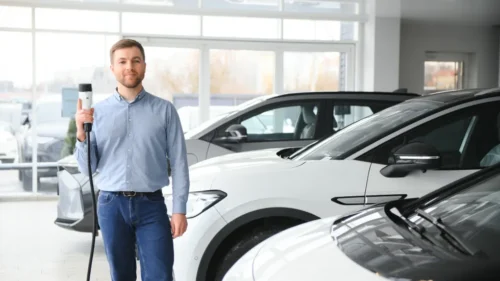On June 23, 2024, German Economy Minister Robert Habeck made a trip to China. This development was unsurprising, as the EU had just announced additional tariffs on Chinese electric vehicles (EVs) on June 12. China did not strike back against the EU’s exports of automobiles but instead chose pork and brandy for anti-dumping investigations. This indicates that Beijing recognizes that Brussels cannot represent Berlin and Paris.
The EU initiated anti-subsidy investigations on Chinese EVs on June 12. From the moment these began, Germans from the government to industry insiders expressed opposition. Chancellor Olaf Scholz even publicly stated that the German automotive industry would be able to compete with Asian car manufacturers.
Typically, a company applies for an investigation. This time, the EU Commission initiated an investigation on its own. So why does European Commission President Ursula von der Leyen not even give the German automotive industry a chance for “fair competition?” The EU clearly had a pre-established position, and the results of the investigation are foreordained. It only targets China; one can only call it another witch hunt.
The EU’s anti-subsidy investigation on Chinese EVs launched in October 2023. Von der Leyen warned that the vehicles would “flood” into Europe. This had the potential to destroy the continent’s automotive industry. It was a reasonable fear; from 2012 to 2013, China damaged Europe’s solar energy industry by selling and illegally dumping €21 billion (over $22 billion) of solar panels there.
Von der Leyen intended to use this new investigation to further transform the EU into a geopolitical institution, which has been a core goal of hers since she took office. Von der Leyen is running for re-election as EU Commission president, and if that fails, she could try for the position of NATO Secretary-General with French and United States aid. So she is simultaneously using the investigation to gather political support, as she presents herself as a hardliner against China in her campaign.
But at what cost is she doing all this? Perhaps the destruction of the Eurasian continent due to trade conflicts? That’s not her concern.
Right-wing protectionism attempts to protect European industry
There’s been a significant rightward shift in the EU’s politics, as evidenced by the results of the 2024 EU parliamentary elections. This change undoubtedly casts a heavy shadow over China’s tariff policy. Rising conservative European forces will inevitably use trade protectionism to defend their own industries and employment. In response, these member states have further strengthened their demands to protect their own automotive jobs. Currently, at least seven EU countries provide land subsidies for industrial investment and several more provide preferential loans to enterprises.
This move completely caters to right-wing populism. (What comes after the rightward turn? The last time Europe faced the storm of populism and trade protectionism was in Germany before World War II.) Given China’s cost and technological advantages in EVs and wind power, the EU’s restrictions will also delay its efforts in energy conservation and emission reduction. This further delays its goals to address global climate change, which is incongruous with the EU’s claims of leading global climate governance.
Trade protectionist policies initiated by the US have also propelled the growing protectionism within the EU. In 2022, the US introduced the Inflation Reduction Act, which provides up to $7,500 in tax credits for new EVs and loans for used EVs. This move raised concerns within the EU about the impact on its own automotive industry and has led to the adoption of trade protectionist measures.
Meanwhile, the US’s recent trade war and decoupling practices against China have intensified the EU’s concerns about its own industrial development and security. In May 2024, the US announced an increase in tariffs on Chinese EVs from the previous 25% to 100%. The European Commission immediately followed suit by firing at Chinese EVs. This was hardly a coincidence.
The EU’s discriminatory subsidies and weaponized tariffs
For a long time, China and Europe have maintained a “cold politics, hot economy” model of cooperation — ideological differences do not affect both sides as important trade partners. However, this new emotional prejudice will chill the few commonalities between China and Europe. Von der Leyen seems to have forgotten that it was Europe itself that initiated the subsidy era in the field of new energy.
On February 1, 2023, von der Leyen officially launched the Green Deal Industrial Plan. This relaxed restrictions on government subsidies to enterprises, which is usually prohibited by the rules of the EU single market. But under the current policy on batteries, EU member states can offer financial assistance to battery manufacturers.
This plan was originally intended to improve Europe’s competitiveness in the field of clean energy, but its actual implementation has created discriminatory subsidies. According to statistics, the EU has provided €3 billion ($3.2 billion) in subsidies to battery manufacturers.
This EU tariff investigation has exposed the division within the EU, with countries like Germany and Hungary expressing opposition. Meanwhile, countries that do not export their own cars to China, represented by France, support the EU’s imposition of tariffs. In fact, Paris plans to raise the threshold for Chinese EVs entering the EU market, forcing Chinese manufacturers to invest and construct factories in France. As early as May, French Finance Minister Bruno Le Maire publicly stated that he welcomes the automotive manufacturer BYD to build factories there.
Like France, those who support increasing tariffs on Chinese cars have communicated with Chinese officials and car companies, expressing their will to cooperate. These countries do not oppose Chinese EVs, but rather the fact that they cannot benefit from them. They hope the companies will cooperate to drive the development of Europe’s automotive industry.
Objectively speaking, this goal is not difficult to achieve. Before this tariff policy started, manufacturers such as BYD had already started building factories in the EU. However, if Europeans use tariffs as a weapon to force China to build factories on their soil, that is a different story.
Can the EU’s automotive industry really develop if Chinese EVs are kept away? The protective tariffs have achieved nothing but delaying the use of low-cost, low-carbon energy in Europe by a few years. The EU’s anti-subsidy investigations can’t solve the problems faced by the EU in related industries, but may further worsen the situation. European consumers welcome inexpensive electric vehicles as well as low-carbon energy; after the anti-subsidy investigation, the EU members may have to buy Chinese EVs at higher prices. The only group not grateful for the reduced carbon dioxide emissions because of China is the EU, which has chosen a tariff war.
Europe and China could cooperate
The cooperation potential between China and Europe’s automotive industries far exceeds their differences. With electrification and intelligentization — the use of artificial intelligence with decision-making capability — the proportion of the cost of chips in car prices will rise dramatically. Although the Netherlands has photolithography technology and Germany has polysilicon, the majority of the chip industry’s profits goes to the US and the non-European countries like Japan and South Korea.
In this regard, China and Europe have common interests. China must develop its own chip industry. With its production capacity, the chip prices will definitely be reduced followed by the increased proportion of its chips in the global market. This is already in effect.
From January to May 2024, China’s integrated circuit export amounted to 444.73 billion renminbi (over $62 billion), a year-on-year increase of 21.2%, even exceeding the 20.1% of cars. It became the country’s second-largest industry with year-on-year growth. China has already occupied the popular mature process nodes of 28-40nm. Most car chips use 28nm or 40nm chips, so cooperating with China to use its chips can greatly reduce the production cost. The two countries would gain a competitive edge over US and Korean cars.
If the European automotive industry can’t cooperate with China in this game, Europe cannot participate as a player. Rather, it would be more like a bargaining chip. Habeck’s visit to China is a signal that Berlin has reached a consensus with Beijing to “decrease the impact” while Paris is still facing choices.
[Lee Thompson-Kolar edited this piece.]
The views expressed in this article are the author’s own and do not necessarily reflect Fair Observer’s editorial policy.
Support Fair Observer
We rely on your support for our independence, diversity and quality.
For more than 10 years, Fair Observer has been free, fair and independent. No billionaire owns us, no advertisers control us. We are a reader-supported nonprofit. Unlike many other publications, we keep our content free for readers regardless of where they live or whether they can afford to pay. We have no paywalls and no ads.
In the post-truth era of fake news, echo chambers and filter bubbles, we publish a plurality of perspectives from around the world. Anyone can publish with us, but everyone goes through a rigorous editorial process. So, you get fact-checked, well-reasoned content instead of noise.
We publish 3,000+ voices from 90+ countries. We also conduct education and training programs
on subjects ranging from digital media and journalism to writing and critical thinking. This
doesn’t come cheap. Servers, editors, trainers and web developers cost
money.
Please consider supporting us on a regular basis as a recurring donor or a
sustaining member.
Will you support FO’s journalism?
We rely on your support for our independence, diversity and quality.








Comment